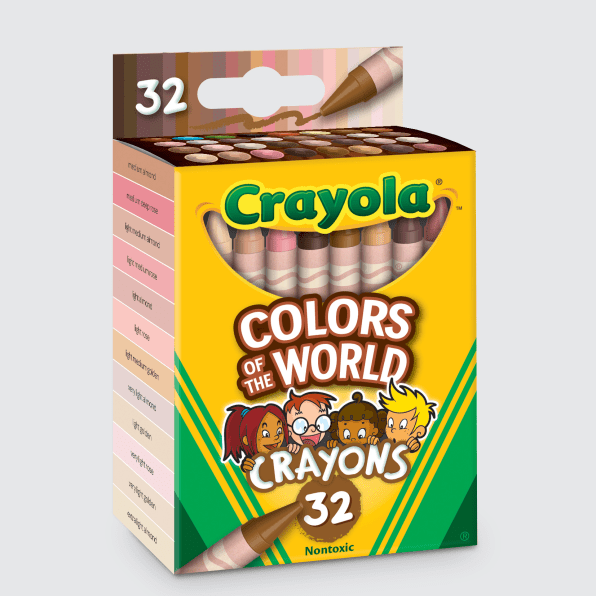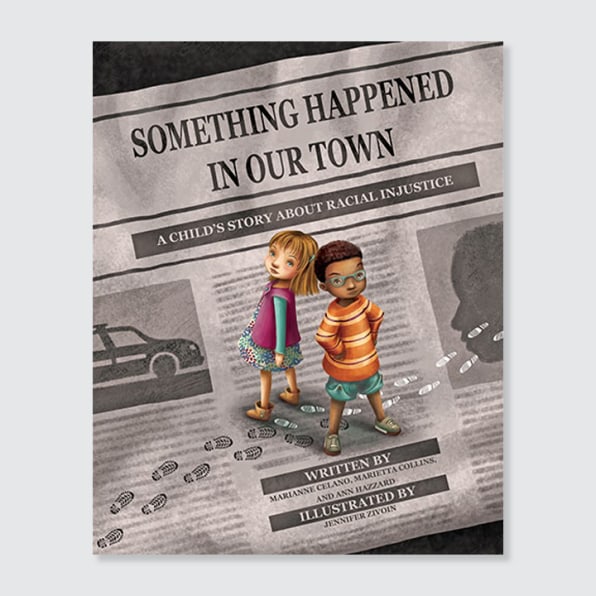Is It Ok to Gift a White Baby Doll Toy to a Black Child
Over the past two weeks, every bit I've watched the biggest ceremonious rights movement in decades accept agree of America, I've wanted to bring my 4-year-old girl into the conversation well-nigh racial justice. The problem is, every time I endeavor to talk to her well-nigh it I stumble. Recently, she'due south been asking questions about the protesters who gather in our neighborhood with manus-drawn Blackness Lives Matter signs. But I don't know how to start talking about the fight for racial justice without addressing police brutality or slavery.
Like parents beyond the country, I've turned to storybooks and toys that will help me talk to her virtually race and racism. Since Memorial Day, when George Floyd was killed by the police, there's been a spike in sales of products that help educate children about racial bug. Subscriptions to kids' book clubs from Conscious Kid, an organization devoted to reducing bias, and Piffling Feminist, which focuses on race and gender, have seen an increment. Something Happened in Our Town, a book that helps preschoolers learn nearly police killings, has been out of stock for weeks. And many Black dolls at brands like Harper Iman and Manhattan Toy Company have likewise sold out.
But as I watch Ella snuggle with her dark-skinned babydoll and utilize her new multicultural crayons to represent the range of peel tones in our family, I've wondered whether these products are actually helping her process race and racism. I talked to three experts who have studied this question over the form of their careers. They said that while diverse books and toys tin can exist crucial tools for helping raise anti-racist kids, parents need to be on manus to answer their questions and provide important context. Hither's how.
Parents take a window to shape kids' views on race
To start with, all of the experts I spoke with said that it's of import to recognize that children are not colorblind. They are acutely aware of racial difference. Children every bit immature as 3 months onetime can identify differences in skin color and hair texture, and as they get older they are very curious about these differences. By the time they are seven, children'south ideas about race tend to be fixed. In the famous Clark Doll Exam, children of all races between the ages of three and seven consistently adopt white dolls and assign more positive characteristics to them than to black dolls. "They are already able to reflect what they've seen in society, which is our bureaucracy of racial categories," says Dr. Lucretia Drupe, an teaching specialist and founder of the advocacy organization Brownicity, which offers webinars well-nigh how to become anti-racist.
If parents don't intervene to requite their children a narrative almost why racial difference exists through books, toys, and regular conversations, they will come to their ain conclusions based on ideas they accept in from culture. In Ella's case, for instance, seeing so many white princesses might prompt her to believe that nighttime-skinned people don't have the qualities associated with princesses, like beauty and power. "Children are actively making meaning based on what they're seeing and they tell stories to explain what is going on," Berry says. "If we don't help them, they don't have the language and words they need to ask the questions. Yous want to engage and normalize conversations about skin tone and race as early as possible."
Office of the problem, according to Beverly Tatum, psychologist and quondam president of Spelman College, is that many adults shut downwards their children's questions about race because they come off as insensitive or racist. A child might ask: "Is that boy so dark because he's muddied?" Or Ella's question to me when she was younger: "Are you brown because y'all eat so much chocolate?" Tatum says questions like this come up out of their ain experiences: A kid may have observed his skin looking browner after playing in the dirt, or noticed that someone's skin tone is the same color every bit a particular food. The problem is that by refusing to address uncomfortable questions, children get the idea that it'due south inappropriate to talk about race. "Many children are taught that they can't talk about race," Tatum says. "So while parents call up they are colorblind, they are, in fact, color silent."
Berry says that filling your dwelling with books and toys that reflect various peel tones can aid start these conversations and as well create the right narratives almost race in your home. But parents likewise need to exist prepared to respond kids' questions when they come up. "It's of import to stay i footstep ahead of them, at least," she says. "Yous desire to give them an understanding of race and history long before they encounter it in school."

In my home, for instance, having crayons that are designed to reflect a wide range of skin tones has been very helpful. Recently, my daughter has been struggling to place her ain skin tone. My hubby is Caucasian, I'm half Chinese and half Indian with light brown skin, and she has an olive complexion. The old box had fewer skin color options, and she used brown to depict me and white to draw her father and herself, prompting her to ask if I'm a different race from the two of them. But with the new box, she's able to pick different shades for each of us. This has allowed us to talk virtually how pare color is determined by melanin.
Drupe says there is no formula for figuring out exactly what kind of conversation to accept with your kid and at what age: It all depends on the child'due south maturity level and their social context. Families in white neighborhoods will have to work harder to give their children a more than complex agreement of race and push back confronting mainstream narratives. "A child growing up in a homogenous neighborhood is going to have different questions from one that is raised in a multicultural i," says Berry. "That's why it's important to mind to them and pay attending to what they are ready to hear."
Kids can handle tough realities
For toddlers and preschoolers, questions will likely hinge on racial differences, like what makes someone have dark pare and another have light skin. Drupe and Tatum say it'south helpful to talk nearly information technology in a simple way, focusing on how every person's skin tone and hair texture is different and adamant by genetics. But it doesn't accept long for kids to start realizing that people of different skin tones are treated differently. For young children, this might be axiomatic in the fact that there are fewer night-skinned superheroes or princesses, or that people of color are not represented in their storybooks or toys.
Experts say information technology's important to get out of your way to diversify your children's toy and book collection to disrupt these cultural narratives. There are many sources designed to assistance parents detect multicultural books for children, including Social Justice Books, Conscious Kid, and Little Feminist. Merely it can exist hard to create the right rest. Merely 22% of children's books are about people of color, and multicultural toys are also underrepresented on the toy aisles.
Despite your all-time efforts, you might discover that the heroes of your child's storybooks are still predominantly white. Berry says that this too can be a conversation starter, even with modest kids. "You lot can say that, historically, people of the white category perceived themselves to be the ideal man, and projected those ideas into laws, policies, textbooks, and stories," she says. "But it's our job to know better."
Tatum, who is Blackness, says it is possible to talk to even young children most issues similar slavery and law violence, if it comes upwards and they ask questions about it. The key is to do and then in a way that is truthful, but still makes them feel safe and empowered. In her own case, she had to talk over slavery with her 4-twelvemonth-erstwhile son in a grocery store when he asked near why his people didn't just stay in Africa. "I couldn't give him an honest reply without talking well-nigh slavery," she says. "So I told him nearly how people brought Africans to the United States to work on farms, but did not pay them, and this was very unfair. And I wanted to highlight that they weren't victims, so I talked nearly how both Blackness and white people fought hard to make things right."

Here again, books can exist very helpful. Books likeSomething Happened in Our Town, which came out in 2018 and was written by iii psychologists, addresses a constabulary killing in a way that is gentle. A story called Henry's Freedom Box tells the truthful story about a child who fought his fashion to freedom by taking the Hole-and-corner Railroad. Both are appropriate for children equally young every bit four. "Books are a great resource considering they allow kids to process big ideas slowly, bit by bit, every fourth dimension you read information technology," says Ramón Stephens, cofounder of The Conscious Kid. "Only over time, it gives them the framework to ask more difficult questions."
Nosotros demand to modify ourselves
The experts point out that books and toys are not enough to raise compassionate, anti-racist children. In the finish, children are watching how their parents behave, and then information technology is important to model the right behavior for them when it comes to race. Stephens says that being introspective every bit y'all procedure these issues with your children can aid illuminate your own bullheaded spots. "Books and dolls are only the starting point," he says. "Y'all need to accept a broader lifestyle switch, and be conscious about the friends yous have in your own circumvolve, the racial demographics of your schoolhouse."
Stephens too says that modeling protest and resistance is helpful, because information technology shows kids that the status quo isn't fixed and is open to change. This might mean telling your child about a protestation you attended, showing them a letter y'all wrote to a senator, or taking them to the polling booth when you vote. Stephens says he'southward been showing his own 4-yr-old son images of protesters and trying to break downwardly the situation to him. "I told him, 'In that location accept been unfair rules that take shaped people'southward perspectives so that they don't like Black people, unfortunately. Merely if you expect at these protests, there are all of these people who are saying that this is incorrect and they want to practice something to change it.'"
Information technology'south a uncomplicated enough caption. I think I'll use it with Ella the next time nosotros drive by the protest in our neighborhood. Maybe nosotros'll even become out of the motorcar and join them.
Source: https://www.fastcompany.com/90517423/3-experts-on-how-to-raise-anti-racist-kids
0 Response to "Is It Ok to Gift a White Baby Doll Toy to a Black Child"
Post a Comment